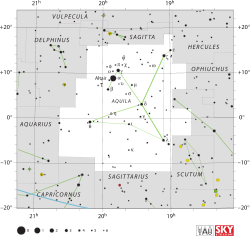Pi Aquilae

| |
| Observation data Epoch J2000 Equinox J2000 | |
|---|---|
| Constellation | Aquila |
| Right ascension | 19h 48m 42.05765s[1] |
| Declination | +11° 48′ 57.2177″[1] |
| Apparent magnitude (V) | 5.85 (6.47/6.75)[2] |
| Characteristics | |
| Spectral type | G8 III: + A1 V[2][3] |
| Astrometry | |
| Radial velocity (Rv) | +12.6[3] km/s |
| Proper motion (μ) | RA: +16.16[1] mas/yr Dec.: –10.60[1] mas/yr |
| Parallax (π) | 6.34 ± 0.52[1] mas |
| Distance | 510 ± 40 ly (160 ± 10 pc) |
| Other designations | |
Pi Aquilae (π Aql, π Aquilae) is the Bayer designation for a binary star[2] system in the equatorial constellation of Aquila, about 3° to the north of the bright star Altair.[3] The apparent visual magnitude of the system is 5.85,[2] making it faintly visible to the naked eye from dark suburban skies. Based upon an annual parallax shift of 6.34 mas, the distance to this system is roughly 510 light-years (160 parsecs).[1]
The binary nature of this system was first discovered by William Herschel in 1785.[3] The primary component of is a magnitude 6.47[2] giant star with a stellar classification of G8 III:.[2] A companion star at an angular separation of 1.437 arcseconds is an A-type main sequence star with a classification of A1 V.[2] It is slightly fainter, with an apparent magnitude of 6.75.[2]
References
- ↑ 1.0 1.1 1.2 1.3 1.4 1.5 van Leeuwen, F. (November 2007), "Validation of the new Hipparcos reduction", Astronomy and Astrophysics 474 (2): 653–664, arXiv:0708.1752, Bibcode:2007A&A...474..653V, doi:10.1051/0004-6361:20078357.
- ↑ 2.0 2.1 2.2 2.3 2.4 2.5 2.6 2.7 Eggleton, P. P.; Tokovinin, A. A. (September 2008), "A catalogue of multiplicity among bright stellar systems", Monthly Notices of the Royal Astronomical Society 389 (2): 869–879, arXiv:0806.2878, Bibcode:2008MNRAS.389..869E, doi:10.1111/j.1365-2966.2008.13596.x.
- ↑ 3.0 3.1 3.2 3.3 Griffin, R.; Griffin, R. (December 1989), "Composite Spectra - Part Three - Pi-Aquilae", Journal for the History of Astronomy 10 (4): 433, Bibcode:1989JApA...10..433G, doi:10.1007/BF02715077
- ↑ "CCDM J19487+1149AB -- Double or multiple star", SIMBAD Astronomical Database (Centre de Données astronomiques de Strasbourg), retrieved 2012-07-20.
External links
| ||||||||||||||||||||||||||||||||||||||||||||||||||||||||||||||||||||||